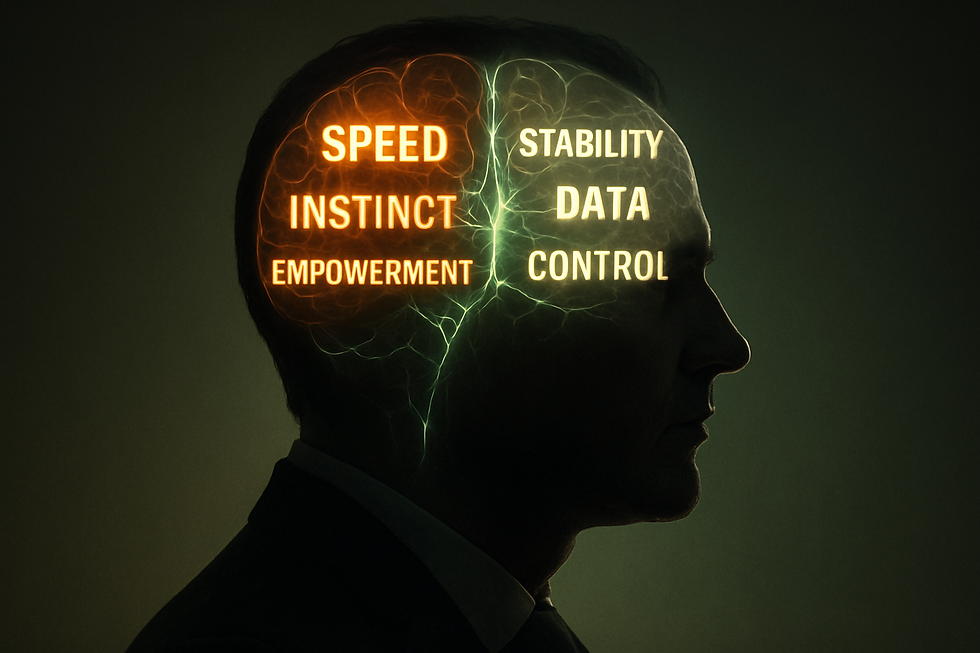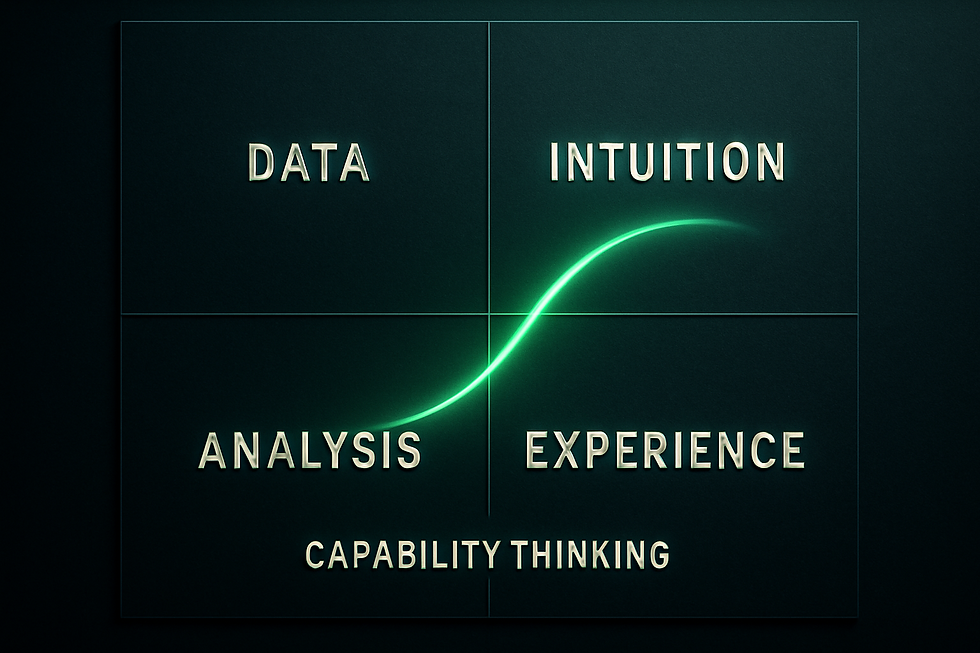4 Leadership Paradoxes - and the Skill That Resolve Them
- Tomorrows Compass

- Jun 4
- 4 min read
Introduction: The Age of Either/And
In a business world obsessed with clarity and decisiveness, paradoxes can feel like a threat. But today’s complexity doesn’t reward binary thinking - it demands Paradoxical Thinking: the ability to embrace opposing truths and hold them in productive tension.

Rather than asking “Which side is right?”, capable leaders ask, “How do we integrate both?”
Whether you're navigating global expansion and local nuance, data and gut instinct, or stability and innovation - Paradoxical Thinking is the mental model that turns contradiction into competitive edge.
1. Speed vs. Stability
The Paradox:
Modern businesses must move fast - pivoting in response to disruption, customer feedback, and market shifts. But they also need long-term stability - consistent values, culture, and infrastructure.
The Tension:
Too much speed, and execution becomes chaotic.
Too much stability, and the business stagnates.
Paradoxical Thinking in Action:
Leaders skilled in Paradoxical Thinking recognize that speed and stability are not enemies - they are different layers of the same system.
They create stable platforms that support agile execution: think modular strategy, clear values, and evolving playbooks. Strategic plans are not rigid; they’re responsive, grounded in a strong core.
Case in Point:
Amazon’s leadership principles embrace both: “Be bold” and “Have backbone.” Teams are encouraged to move fast, but grounded in enduring mechanisms like bar-raising hiring and rigorous decision-making frameworks.
2. Data vs. Intuition
The Paradox:
We’re told to be “data-driven.” But data doesn’t tell you what not to measure - and it rarely captures human nuance. Meanwhile, intuition is dismissed as “soft,” despite being the product of deep experience.
The Tension:
Over-reliance on data leads to analysis paralysis or false confidence.
Over-reliance on intuition risks cognitive bias or lack of accountability.
Paradoxical Thinking in Action:
Great leaders don’t choose between data and instinct. They use data to challenge their instincts, and instincts to question their data.
They create decision cultures where dashboards and gut feel meet - and where opposing views are actively sought out.
Case in Point:
At Netflix, Reed Hastings famously emphasized “freedom and responsibility” - but decision-making wasn’t just freewheeling. It blended data-led testing with narrative memos, allowing subjective insight and objective analysis to coexist.
3. Control vs. Empowerment
The Paradox:
You want high standards and accountability - but also initiative and ownership. You want empowered teams - but also alignment and control.
The Tension:
Too much control kills creativity and engagement.
Too much empowerment without structure leads to inconsistency or drift.
Paradoxical Thinking in Action:
Paradoxical leaders don’t think of empowerment as “letting go.” They design the conditions for autonomy: clear expectations, feedback loops, and boundaries that free people to act within them.
This is “bounded freedom” - a paradox that works when leaders think in systems, not silos.
Case in Point:
Spotify’s “Squad” model gives product teams high autonomy - but within a clearly defined strategic direction and shared architecture. Governance and creativity live side by side.
4. Long-Term Vision vs. Short-Term Pressure
The Paradox:
The market rewards quarterly results. But enduring impact comes from long-term vision - the kind that outlasts product cycles and economic downturns.
The Tension:
Chasing only short-term results undermines sustainability and purpose.
Focusing only on the long-term can ignore pressing realities and burn cash.
Paradoxical Thinking in Action:
Leaders must develop dual-mode time horizons - zooming in and out with fluency. They create “today actions” that serve “tomorrow outcomes.”
They link tactical sprints to strategic narratives. Even quarterly goals are tied to a larger arc.
Case in Point:
Tesla’s business is built around a century-long energy transition - but it still hits quarterly production targets and engages short-term investors. The paradox is managed, not resolved.
Why Paradoxical Thinking Is the Meta-Skill
Paradoxical Thinking isn’t about sitting on the fence. It’s about developing the cognitive agility to recognize dual truths and hold space for creative resolution.
It asks:
Can both be true?
What integration creates the best of both?
What’s the third path?
It’s a capability - not a trait. And like any capability, it can be learned, practiced, and embedded into culture.
Cultivating Paradoxical Thinking
To build this muscle in your team or organization:
Name the tension. Get clear on the opposing forces at play.
Frame both sides as valid. Avoid the trap of false binaries.
Create holding environments. Spaces where the discomfort of tension is safe and productive.
Design integrative moves. Look for solutions that honor both sides.
Reward ambidexterity. Celebrate people who balance stability with change, analysis with instinct, now with next.
Final Thought: The Edge is in the And
As leadership becomes more complex, the edge doesn’t go to those who pick faster - it goes to those who think deeper.
Paradoxical Thinking gives leaders an edge not just in decision-making, but in shaping cultures, strategies, and systems that thrive in duality.
The future belongs to those who can hold tension without breaking - and turn contradiction into possibility.

Ready to Think in Paradoxes?
Tomorrow’s Compass helps leaders build Paradoxical Thinking as a measurable, trainable capability - not a vague trait.
If you’re navigating complex decisions, competing priorities, or strategic tensions, start by understanding your unique capability profile.
Explore the Navigator Report for a deeper dive into your leadership edge.
The next-level leader doesn’t choose between opposing truths - they harness both.
Let’s build that kind of thinking into your leadership DNA.


